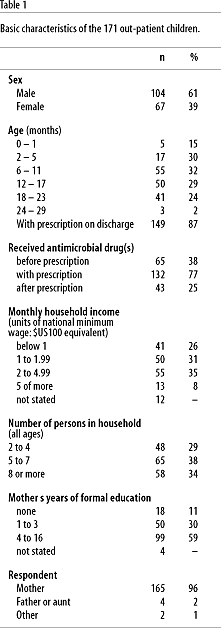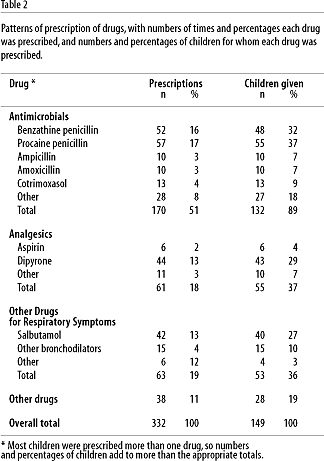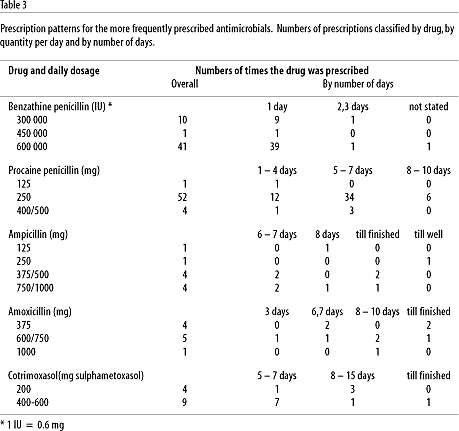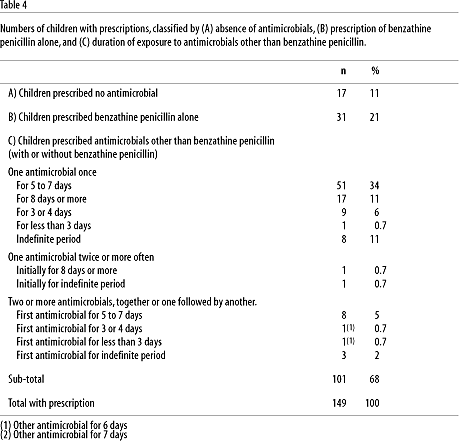| ARTIGO ARTICLE |
|
Chizuru Misago 2 | Out-patient drug treatment of pneumonia among children under two years of age in Fortaleza, Brazil 1 Tratamento ambulatorial das pneumonias nas crianças menores de dois anos em Fortaleza, Brasil 1
|
| 1 Supported with grants from the Toyota Foundation and the ARI programme of the World Health Organization. 2 Maternal and Child Epidemiology Unit, London School of Hygiene and Tropical Medicine, London WC1E 7HT, UK. 3 Departamento de Saúde Comunitária, Universidade Federal do Ceará, Rua Barbosa de Freitas, 650/402, Fortaleza, CE, 60170-020, Brazil. | Resumo Estudou-se a aderência ao tratamento de pneumonia em crianças, em serviço ambulatorial de hospital pediátrico em Fortaleza, Brasil. Foram investigadas 171 crianças com diagnóstico de pneumonia. Através de questionário foram coletadas informações referentes à prescrição médica e estimada a aderência ao tratamento de 149 crianças. Os antimicrobianos mais comumente prescritos foram penicilina procaína (33%), penicilina benzatina (31%), ampicilina ou amoxacilina (12%) e cotrimoxazol (8%). Embora tenha sido freqüente a associação de antimicrobianos com outros medicamentos, tratamento exclusivo com penicilina procaina foi prescrito para 31 crianças. A aderência ao uso de antimicrobianos foi de 52%, tendo sido mais elevada para os pacientes tratados exclusivamente com medicação injetável. As prescrições médicas combinaram, muitas vezes, diferentes antimicrobianos durante o mesmo tratamento. A análise das diferentes associações antimicrobianas revelou que apenas 81 (54%) crianças receberam tratamento apropriado, por período de cinco ou mais dias. Conclui-se que a identificação de antimicrobianos que possam resultar na maior aderência ao tratamento permanece como um dos principais desafios no manejo ambulatorial das pneumonias nas crianças. Outros medicamentos incluíram os analgésicos e broncodilatadores. Palavras-chave Pneumonia; Morbidade; Saúde da Criança; Tratamento Abstract Results are reported from a study on drug use in treatment of children with pneumonia in a pediatric hospital in the city of Fortaleza, Northeastern Brazil. There were 171 out-patients; prescription details were obtained for 149. The most commonly prescribed antimicrobial drug was procaine penicillin, accounting for 33% of antimicrobial prescriptions, followed by benzathine penicillin (31%), ampicillin or amoxicillin (12%), and cotrimoxazole (8%). Benzathine penicillin was frequently given with other drugs, but was the sole antimicrobial agent for 31 children. Compliance with antimicrobial treatment was 52% overall and was higher for the injectables. Prescription patterns varied from child to child, and children were often prescribed more than one antimicrobial in the same or repeat prescriptions; combining this information with compliance, 81 (54%) of the children were estimated to have received 5 or more days of appropriate antimicrobial treatment for pneumonia. This percentage is not high, and five days were often reached after using more than one antimicrobial and after repeat visits. The authors concluded that the need remains for simple antimicrobial regimes, attractive to comply with, that can be expected to be consistently used. Other drugs were chiefly analgesics and bronchodilators. |
Introduction
Treatment of acute lower respiratory infections (ALRI) in developing countries is an important health issue. ALRI accounts for approximately 80% of the under-five mortality due to acute respiratory infections, a third of all the deaths in this age group (Shann et al., 1984), and up to 60% of health facility visits and 30% of hos-pital admissions (WHO/UNICEF, 1986). Antimicrobial drugs are central to recommended case management (WHO, 1991) and are often prescribed for home use, but the question of whether they are prescribed appropriately and given at correct doses and frequencies has been little studied (van der Geest, 1987). A recent review (Homedes & Ugalde, 1993) quoted only 37 drug use studies in the developing world, covering a range of diseases and circumstances, but none specifically about severe ALRI.
We report results from a questionnaire-based study of prescription patterns and compliance in children with pneumonia treated as out-patients of the principal pediatric hospital in Fortaleza, Brazil, in 1990. This hospital provides free medical services, including free essential drugs from the government institution CEME (Central de Medicamentos), although CEME drugs are often out of stock so patients cannot always use this source. The study gathered data on the drugs prescribed, if and where they were obtained, and how they were given to the children.
Methods
The study was carried out in the Greater Metropolitan Area of Fortaleza, a city of two million people in Northeastern Brazil, located at 3o South in a tropical zone, one of the least developed areas of the country. At the time of the study the infant mortality rate was some 90 per thousand. Respiratory tract infections are the second most important infectious cause of infant death, accounting for 11% of such deaths (UNICEF, 1989).
Recruitment took place during a case-control study of children aged 0-23 months with pneumonia confirmed by X-ray, attending the hospital out-patient clinic. Full details of the methodology employed have been provided elsewhere (Fonseca et al., 1996).
Over a 6-month period, children living in the metropolitan area of the city were sampled. An interviewer visited the home approximately a week later and interviewed the mother (or carer) using a structured questionnaire. Children treated as out-patients are included here.
The respondents were requested to show the hospital prescriptions, and the drugs where possible; they were asked where these were obtained, how much (if anything) was paid, and dosages and frequencies actually followed. Further questions concerned drugs and home remedies used before attending the hospital and after using the hospital-prescribed drugs, and other general family information.
Compliance is defined as agreement between the prescription and what the respondent stated had been given to the child, with four components of agreement; the drug by name, the amount per dose, the daily number of doses, and the number of days. When the reply was not specific enough, non-compliance was assumed. Sometimes the drug was still being given, and some prescriptions indicated use "until finished" or "until well"; in these instances, with compliance otherwise complete, overall compliance was assumed. Treatment adequacy is defined as 5 days with an antimicrobial other than benzathine penicillin (WHO, 1991). 95% confidence intervals are given for the principal percentages, in parenthesis.
Results
Study population
Carers of 226 children were interviewed, and 171 were out-patients. The general characteristics of the 171 are shown in Table 1. Information was obtained directly from prescriptions for 148, and by mother's recall for one. The remaining 22 carers said they were not given prescriptions at this hospital; some sought care in other hospitals or elsewhere. Most households were large, 34% with eight or more persons, and incomes were generally low. Most mothers (59%) had more than 3 years education. The respondent was almost always the mother.

Prescription Patterns, Compliance, and Overall Antimicrobial Cover
Table 2 shows frequencies of prescription of the more commonly used drugs and numbers of children prescribed each drug or group of drugs at least once. About half the drugs were antimicrobials, prescribed to 89% of the children, with benzathine or procaine penicillin being the most common. Analgesics (notably dipyrone) were the next most frequent, followed by bronchodilators.

127 children received one prescription, 14 received two, 5 received three, and 2 received four. Almost all multiple prescriptions resulted from multiple visits, the majority within a week of each other.
Prescription patterns for the main antimicrobials are shown in Table 3. Benzathine penicillin was usually prescribed for one day. The principal other antimicrobial prescribed for less than five days was procaine penicillin. The following results are for the 149 children with prescription information.

Table 4 shows numbers of children classified by overall prescription patterns for antimicrobials. 17 children were prescribed no antimicrobial, and 31 only benzathine penicillin. 51 children were prescribed another antimicrobial for between five and seven days; this is taken as optimal. 7 children were prescribed a single antimicrobial "until used" or "until well", started before the hospital visit. 18 children were prescribed more than seven days of one antimicrobial. Not counting benzathine penicillin, and presuming that "until used or well" gave adequate coverage, only 10 children were prescribed antimicrobials which were under-prescribed. Of the 17 that were prescribed no antimicrobial, 3 received them shortly before the hospital visit and 7 directly at the hospital (6 as free samples). It appears that antimicrobials were completely absent for only 7 of the 149 children.

Exact compliance with benzathine penicillin was reported for 87% (78% to 96%) of the children prescribed it. Other exact compliance rates are as follows: procaine penicillin 54% (44% to 64%), ampicillin or amoxicillin 50% (28% to 72%), cotrimoxazole 38% (12% to 64%), and all antimicrobials combined 52% (43% to 61%).
Table 5 shows the details of non-compliance for the more frequent antimicrobials. Non-compliance was common, but did not always result in deficient antimicrobial coverage.

Ten of the 77 children with initial prescriptions of antimicrobials for five or more days (Table 4, addition of (a) and (b)) were treated for less than five days on account of non-compliance. Ultimately, whether a child received antimicrobials adequately depended on the combination of all his/her prescriptions and compliance; five days cover was reached for 77 (a different 77), 52% of the 149 (44% to 60%), and a minimum of three days for 60% of the 149 (52% to 68%). Including antimicrobials started before hospital consultation, and continuing at the time, these periods were reached by 4 more children.
Bronchodilators were prescribed to 55 children in a range of daily doses with days generally not specified. Compliance was low at 55%. Compliance to analgesics was lower at 22%. The most common analgesic was dipyrone.
Use of pharmaceutical drugs before hospital consultation
During the four weeks prior to hospital consultation, 140 children received pharmaceutical drugs, 65 at least one antimicrobial, the most common being cotrimoxazole, erythromycin and benzathine or procaine penicillin. Antimicrobials were recommended by a physician 70% of the time, by pharmacy attendants 5%, and chosen by the carer 16%. The most common other drugs were analgesics and bronchodilators.
Discussion
There was considerable variety in prescribing practice, in addition to frequent non-compliance. Only 53% (90/170, Table 2) of the antimicrobial prescriptions were for recommended drugs (WHO, 1991); 31% were for benzathine penicillin and 16% for a variety of other antimicrobials. Treatment was frequently sought more than once and antimicrobials obtained more than once. Allowing for this and for non-compliance, 52% of the children received five or more days antimicrobial cover other than benzathine penicillin, (54% including continuing treatment begun prior to hospital consultation). The figures for three days are 60% and 63%. These percentages are low, partly because benzathine penicillin was the only antimicrobial for 31 children.
The estimates of compliance depend on stated usage being reasonably accurate. Generally, there is support for measuring compliance by interview (Homedes & Ugalde, 1993), but comparisons with pill counts, urine analysis, or other measures have given evidence of overstatement (Wright, 1993; Gordis, 1979), although these other methods themselves can also lack sensitivity and specificity (Gordis, 1979). Many compliance studies have been concerned with prophylaxis or long-term chronic conditions (Haynes et al., 1979); compliance may be higher with shorter term treatment for acute illnesses perceived as serious (Grob, 1992). Our estimates of compliance, except for benzathine penicillin, are not high. The mothers were interviewed independently, away from the hospital, with the questions put in a neutral phrasing. We do not believe overstatement was a serious problem in this study.
Compliance was highest for benzathine penicillin, which was readily available, usually free of cost from the hospital pharmacy, and given as a feasible option for many mothers, quite often at the hospital. It was prescribed fairly often with other antimicrobials but was the only antimicrobial for 31 children. Its use for childhood pneumonia has been common practice in Brazil since being advocated in the São Paulo State ARI program (Pio A, pers comm). But it is specifically not recommended by WHO (WHO, 1991). More recent information shows that its use has since declined at the study site (Rey L. C., pers comm).
Compliance is likely to be higher for treatments given once a day (Grob, 1992). Procaine penicillin was usually prescribed once a day for at least five days. It is injectable. Following a course of injections from the home is not difficult in this community. Mothers obtain the drug at either the hospital or a local pharmacy, and local pharmacy attendants often give follow-up injections even if the drug was obtained elsewhere. There is anecdotal evidence that injections are preferred by many mothers, so compliance may be higher for injectables on this count also. But a clear argument favoring oral drugs for out-patients is the possibility of infection through inadequate sterilization (Pio A, pers comm).
The most common non-antimicrobial was dipyrone. Victora et al. (1982) reported high usage in Southern Brazilian hospitals and expressed concern over safety, which is also discussed by Fuchs (Fuchs, 1988; IAAAS, 1986). The amount of use shown here is cause for concern.
Lower compliance can be expected for prescriptions with many items (Homedes & Ugalde, 1993; Haynes, 1979), which argues for simplicity in prescribing. However, we were not able to show such an effect, though our study may have lacked the power to do so.
Care-providers for children in this study chose hospital care, so they are only a proportion of children with pneumonia. But adequate treatment in this group matters greatly; it is important for health service effectiveness and these patients are a particularly high-risk group. We have found that prescribing practice varies, compliance is a problem, and although most children finally received the recommended five-day antimicrobial cover, this often resulted from more than one prescription or using more than one such drug. Effective, simple, low-cost antimicrobial regimes, with high compliance as a real possibility, and which are followed in practice remain an urgent need in many developing countries.
Acknowledgements
We thank the Albert Sabin Hospital, the Health Secretariat of Ceará State, all the carers who willingly gave us time and information, and the children themselves. We are grateful to Dr. Cesar Victora of the Federal University of Pelotas for his considerable assistance in the conception and initiation of this study, and to Dr. Julian Lob-Levyt of the London School of Hygiene and Tropical Medicine and Dr. Sandy Gove of the ARI Program of the World Health Organization for constructive advice.
References
FONSECA, W.; KIRKWOOD, B. R.; VICTORA, C. G.; FUCHS, S. R.; FLORES, J. A. & MISAGO, C., 1996. Risk factors for Childhood Pneumonia among urban poor in Fortaleza, Brazil: a case-control study. Bulletin of the World Health Organization, 74:199-208.
FUCHS, F. D., 1988. Dipyrone: the risk of agranulocytosis should restrict its use. Ciência e Cultura, 40:1089-1091.
GORDIS, L., 1979. Conceptual and methodological problems in measuring patient compliance. In: Compliance in Health Care (Haynes R.B., Taylor D.W. & Sackett D.L., eds.). Baltimore: Johns Hopkins University Press.
GROB, P. R., 1992. Antibiotic prescribing practices and patient compliance in the community. Scandinavian Journal of Infectious Disease (Supplement), 83:7-14.
HAYNES, R. B.; TAYLOR, D. W. & SACKETT, D. L., 1979. Compliance in Health Care. Baltimore: Johns Hopkins University Press.
HOMEDES, N. & UGALDE, A., 1993. Patients' compliance with medical treatments in the Third World. What do we know? Social Science and Medicine, 8:291-314.
IAAAS (The International Agranulocytosis and Aplastic Anemia Study), 1986. Risks of agranulocytosis and aplastic anemia first report of their relation to drug use with special reference to analgesics. Journal of the American Medical Association, 256:1749-1752.
SHANN, F.; GRATTEN, M.; GERNER, S.; LINNEMANN, V.; HAZLETT, D. & PAYNE, R., 1984. Aetiology of pneumonia in children in Goroka Hospital, Papua New Guinea. The Lancet, 2:537-541
UNICEF, 1989. A Saúde das Crianças Cearenses: Um Estudo de 8.000 Famílias. Fortaleza: UNICEF. (unpublished).
VAN DER GEEST, S., 1987. Pharmaceuticals in the Third World: the perspective. Social Science and Medicine, 25:273-276.
VICTORA, C. G.; FACCHINI, L. A. & FILHO, M. G., 1982. Drug usage in Southern Brazilian hospitals. Tropical Doctor, 12:231-235.
WHO/UNICEF (World Health Organization), 1986. Basic Principles for Control of Acute Respiratory Infections in Children in Developing Countries. Geneva: WHO.
WHO (World Health Organization), 1991. Management of the Young Child with an Acute Respiratory Infection. Geneva: WHO.
WRIGHT, E. C., 1993. Non-compliance or how many aunts has Matilda? The Lancet, 342:909-913.
